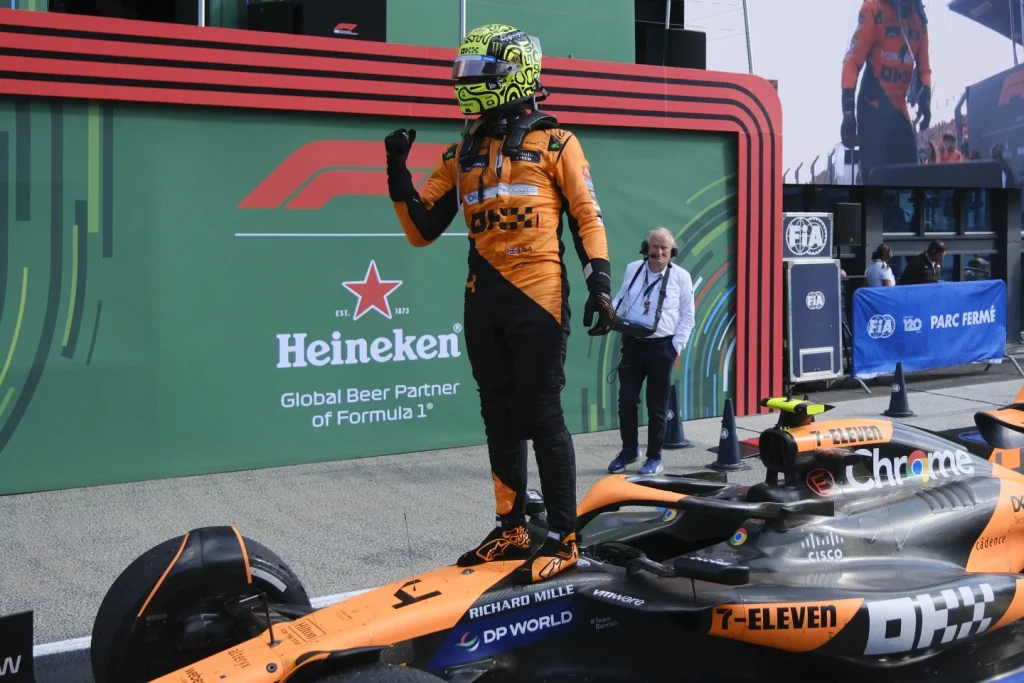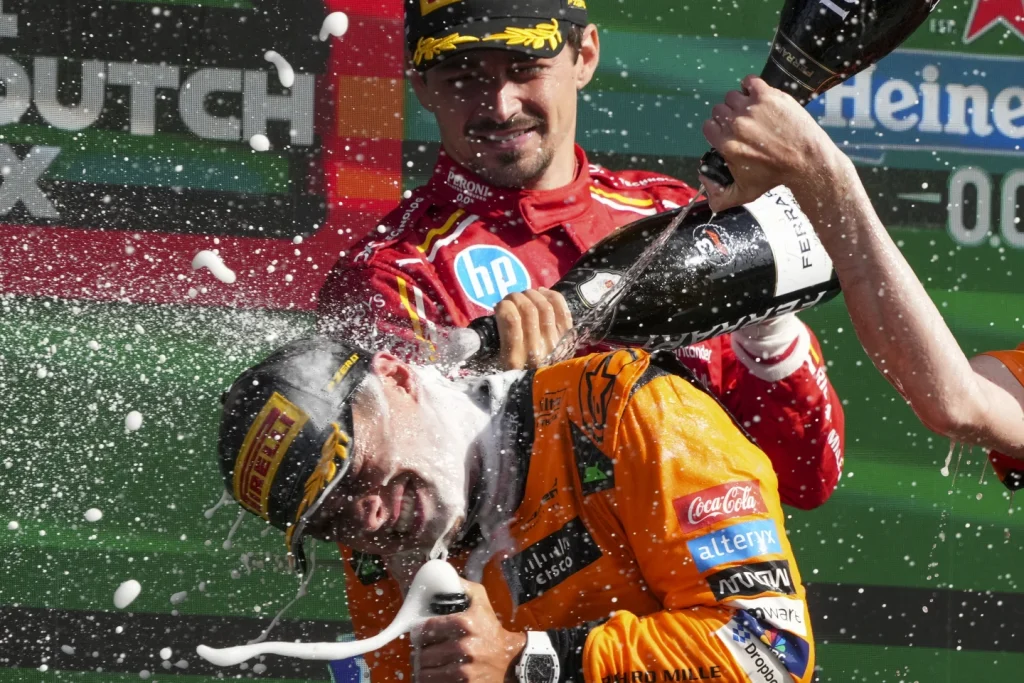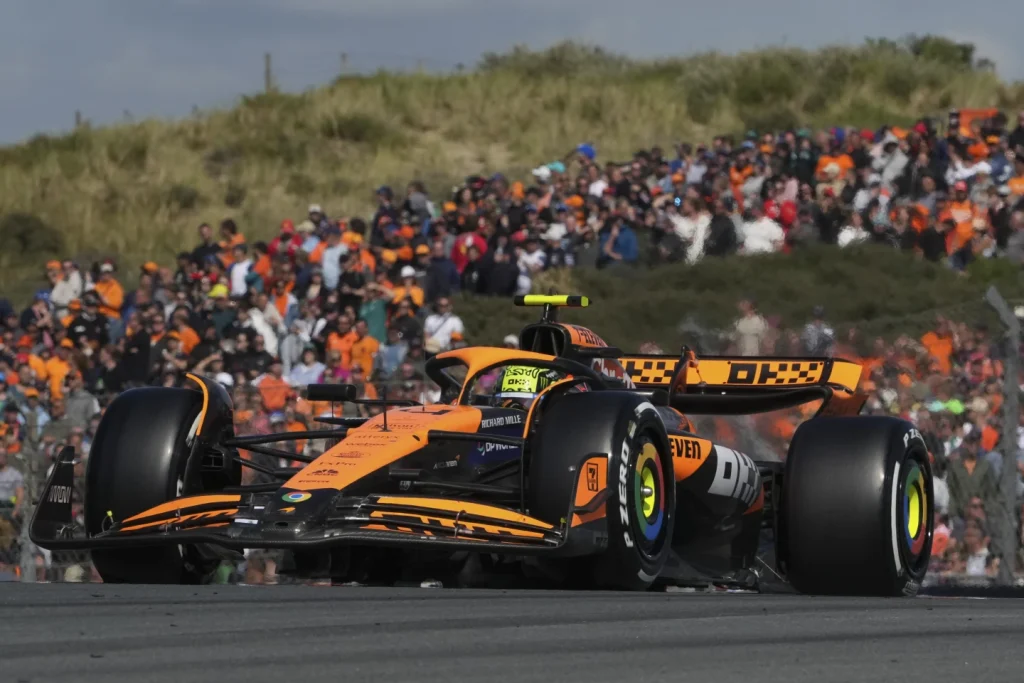Lando Norris’s recent performance at the Zandvoort Grand Prix not only highlights his considerable skill as a driver but also reflects the intricate dynamics of Formula 1 racing, where fortunes can shift with the slightest miscalculation or stroke of brilliance.
Norris’s journey through this race epitomizes the essence of perseverance in the face of ongoing challenges, illustrating how individual talent, team strategy, and thorough understanding of the sport can coalesce into a victorious outcome—even against formidable competitors such as Max Verstappen.
From the outset, Norris’s race was characterized by a familiar struggle that has plagued him in previous outings: poor starts.
Despite securing the pole position—a position denoting the utmost potential for victory—his launch off the line was less than optimal, allowing Verstappen, the reigning champion and local hero, to leap ahead in the early laps.
This initial setback could have easily deflated a driver of lesser mettle; however, what distinguished Norris on this day was his mental fortitude.
Rather than becoming disheartened or allowing frustration to cloud his judgment, Norris exhibited a level of composure that can only be cultivated through experience.
His declaration of being ‘surprisingly calm’ showcased his readiness to pivot from adversity to a proactive racing strategy. His self-awareness and ability to adapt mid-race became crucial factors in his eventual success.
The first significant turning point of the race unfolded on the 18th lap, during a pivotal moment when Norris deftly reasserted his position against Verstappen.
Entering the first corner, known as the banked “Tarzan” turn, Norris executed a calculated maneuver, overtaking Verstappen and reclaiming the lead—a feat that was not just a testament to his driving prowess but also highlighted the tactical element of Formula 1.
The ability to capitalize on an opponent’s vulnerability is critical in a sport where victory and defeat can hinge on precise timing and tactical choices.
Verstappen’s complaints about tire grip further compounded his troubles, as Norris continued to gain ground, ultimately securing a remarkable lead of nearly 23 seconds by the race’s conclusion.
Norris’s post-race reflections shed light on the unusual dynamics at play. Although he had struggled at the start, he recognized the changes in pace between himself and Verstappen once he regained the lead.
His keen insight into the race dynamics helped him understand that Verstappen’s expected retaliatory push was absent, leading him to realize the potential for a strategic victory.
This realization allowed him to focus on maintaining a consistent pace, ensuring that he not only opened a significant gap but also preserved his car’s capabilities for potential race interruptions, such as a safety car.
Norris’s adaptability under pressure demonstrated a well-honed racing acumen, illustrating that victory is not solely about speed but also about reading the nuances of the race.
Moreover, the psychological aspect of this victory cannot be overlooked. Norris’s ability to transform a disappointing start into a strategic comeback indicates a maturity that belies his youth.
Winning after starting from pole for the first time is a noteworthy milestone in his career, suggesting that he is evolving as a driver capable of overcoming not just the physical challenges of the sport, but the mental hurdles as well.

This victory not only bolstered his confidence but also significantly reduced Verstappen’s championship lead from 78 points to 70, a shift that adds a layer of intrigue to the ongoing season.
The implications of this victory extend beyond Norris and the McLaren team; they represent a broader narrative of competition in Formula 1. Norris’s triumph at Zandvoort denotes a moment of vulnerability for Verstappen, historically dominant at his home circuit.
The pendulum of momentum has swung slightly, presenting Norris as a formidable challenger in the remaining races of the season.
As the season progresses with nine races still to unfold, the question looms: Can Norris maintain this momentum and mount a serious challenge for the championship?
In the most recent race, it became evident that Lando Norris and McLaren have decisively established themselves as formidable contenders following latest enhancements to their vehicle, showcasing unparalleled speed throughout various stages of the competition.
This performance heralds the potential for an increasingly intense battle for the championship title between Norris and reigning champion Max Verstappen, particularly as the calendar narrows down to the final nine races of the season.
In stark contrast to his dominance in 2022 and 2023, which saw Verstappen consistently ahead of the competition, he now finds himself grappling with a significant shift in dynamics.
Conclusively, Verstappen crossed the finish line in second place, while Charles Leclerc of Ferrari secured a commendable third position after successfully defending against a determined challenge from Oscar Piastri.
Remarkably, Norris’s victory marks the first time a McLaren driver has triumphed in the Netherlands since Niki Lauda in 1985, a testament to the team’s resurgence in form.
Meanwhile, Verstappen is ensnared in an unusual predicament, enduring a winless streak that extends to five races—his longest drought since 2020.
Expressing his concerns, Verstappen candidly acknowledged, “I think it was quite clear that we’re not quick enough, so I tried to be second today,” implying that there may be underlying issues affecting the performance of his Red Bull car.
He hinted at a dual predicament involving a concerning lack of pace coupled with an unexpected increase in tire degradation, thereby necessitating immediate analysis and rectification from the Red Bull engineering team.
Carlos Sainz Jr. from Ferrari managed to secure a fifth-place finish, closely followed by Verstappen’s teammate Sergio Perez in sixth, culminating a disappointing series for the Mexican driver, as this marked his best finish since a fourth-place standing at the Miami Grand Prix in May.
Amid contrasting fortunes within the Mercedes garage, George Russell initially claimed third but subsequently faltered to finish seventh, while Lewis Hamilton, having started from 14th due to a grid penalty, made a commendable rise to eighth place.
Further down the field, Pierre Gasly brought home ninth for Alpine, with Fernando Alonso rounding out the top ten in an Aston Martin.

Notably, McLaren has successfully narrowed the gap to Red Bull in the constructors’ championship standings to a mere 30 points, intensifying their pursuit of a title that has eluded them since 1998.
This sequence of events underlines the shifting tides of Formula One, where competition is becoming increasingly fierce as teams adapt and strive for excellence in pursuit of championship glory.
In conclusion, Lando Norris’s exhilarating victory at the Zandvoort Grand Prix stands as a salient reminder of the unpredictable and complex nature of Formula 1 racing.
It underscores the importance of resilience, adaptability, and strategic thinking—qualities that define a successful racer.
As Norris continues to refine his skills and learn from both triumphs and setbacks, one can only anticipate a fierce competition in the races to come, heralding a promising chapter for both him and the McLaren team as they strive for excellence on the world stage of motorsport.
